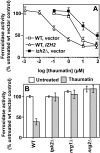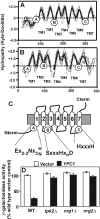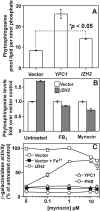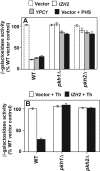Sphingolipids function as downstream effectors of a fungal PAQR
- PMID: 19066337
- PMCID: PMC2684929
- DOI: 10.1124/mol.108.049809
Sphingolipids function as downstream effectors of a fungal PAQR
Abstract
The Izh2p protein from Saccharomyces cerevisiae belongs to the newly characterized progestin and adipoQ receptor (PAQR) superfamily of receptors whose mechanism of signal transduction is still unknown. Izh2p functions as a receptor for the plant PR-5 defensin osmotin and has pleiotropic effects on cellular biochemistry. One example of this pleiotropy is the Izh2p-dependent repression of FET3, a gene involved in iron-uptake. Although the physiological purpose of FET3 repression by Izh2p is a matter of speculation, it provides a reporter with which to probe the mechanism of signal transduction by this novel class of receptor. Receptors in the PAQR family share sequence similarity with enzymes involved in ceramide metabolism, which led to the hypothesis that sphingolipids are involved in Izh2p-dependent signaling. In this study, we demonstrate that drugs affecting sphingolipid metabolism, such as d-erythro-MAPP and myriocin, inhibit the effect of Izh2p on FET3. We also show that Izh2p causes an increase in steady-state levels of sphingoid base. Moreover, we show that Izh2p-independent increases in sphingoid bases recapitulate the effect of Izh2p on FET3. Finally, our data indicate that the Pkh1p and Pkh2p sphingoid base-sensing kinases are essential components of the Izh2p-dependent signaling pathway. In conclusion, our data indicate that Izh2p produces sphingoid bases and that these bioactive lipids probably function as the second messenger responsible for the effect of Izh2p on FET3.
Figures

 ). Error bars indicate
± 1 S.E. (n = 3). ▵, isogenic strains lacking particular
genes.
). Error bars indicate
± 1 S.E. (n = 3). ▵, isogenic strains lacking particular
genes.





Comment in
-
PAQRs: a counteracting force to ceramides?Mol Pharmacol. 2009 Apr;75(4):740-3. doi: 10.1124/mol.109.054817. Epub 2009 Jan 21. Mol Pharmacol. 2009. PMID: 19158359 Free PMC article. Review.
References
-
- Altschul SF and Koonin EV (1998) Iterated profile searches with PSI-BLAST-a tool for discovery in protein databases. Trends Biochem Sci 23 444-447. - PubMed
-
- Bligh EG and Dyer WJ (1959) A rapid method of total lipid extraction and purification. Can J Biochem Physiol 37 911-917. - PubMed
-
- Casamayor A, Torrance PD, Kobayashi T, Thorner J, and Alessi DR (1999) Functional counterparts of mammalian protein kinases PDK1 and SGK in budding yeast. Curr Biol 9 186-197. - PubMed
Publication types
MeSH terms
Substances
Grants and funding
LinkOut - more resources
Full Text Sources
Molecular Biology Databases
Research Materials
Miscellaneous

